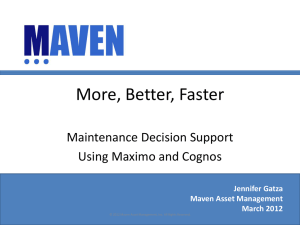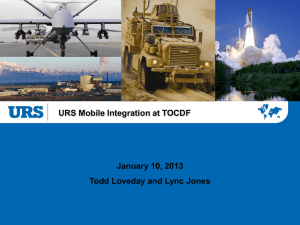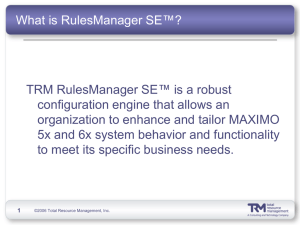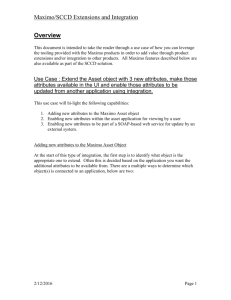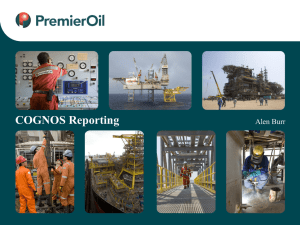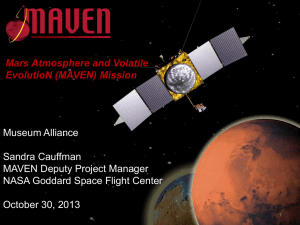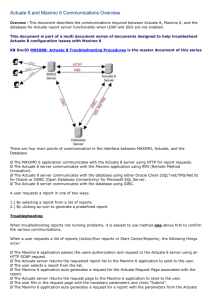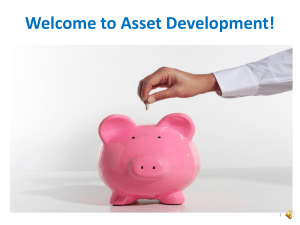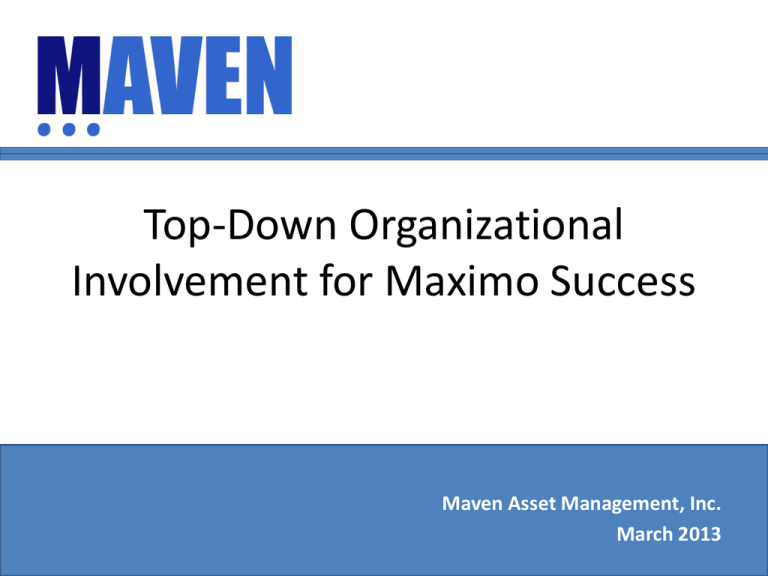
Top-Down Organizational
Involvement for Maximo Success
Maven Asset Management, Inc.
March 2013
Top-Down Organizational
Involvement for Maximo Success
• “Top-down” in this presentation refers to involvement of the most
appropriate people at all levels of the organization. (High-involvement)
• This is NOT meant to represent traditional “top-down”, “cascade” or
“waterfall” management methods.
• Likewise, this is not intended to be a discussion of management
science, however lessons learned from various change management
models will be discussed in the context of Maximo implementation or
upgrade scenarios.
• We will consider best organizational practices in the context of
planning a Maximo deployment or upgrade.
© 2013 Maven Asset Management, Inc. All Rights
Reserved.
Top-Down Organizational
Involvement for Maximo Success
• Leadership’s role
• Involvement of mid-level managers and supervisors
• Clearly defining roles and responsibilities
•Aligning Maximo with best business practices
•The need for a training and qualification plan
• Measuring and recognizing the value participants bring
• Providing the right information to the executive level
• Leadership buy-in, commitment
© 2013 Maven Asset Management, Inc. All Rights
Reserved.
Leaders establish unity of purpose and direction for the organization.
They should create and maintain the internal environment in which people
can become fully involved in achieving the organization’s objectives.
ISO/TC 176 – QMP_2012
New Maximo deployments, upgrades and many expansions are
examples of leadership establishing purpose and direction.
This becomes obvious when considering reasons for doing so:
•Improve current processes
•Implement best practices
•Reduce operating downtime
•Manage maintenance inventory
•Reduce Maintenance cost
These are significant organizational change events.
© 2013 Maven Asset Management, Inc. All Rights
Reserved.
Leaders establish unity of purpose and direction for the organization.
They should create and maintain the internal environment in which people
can become fully involved in achieving the organization’s objectives.
ISO/TC 176 – QMP_2012
New Maximo deployments, upgrades and many expansions are
examples of leadership establishing purpose and direction.
Leadership recognizes needs and initiates change.
•Improve current processes - Previously “home-grown”?
•Implement best practices - Current methods are “patchwork”?
•Reduce operating downtime - Improve output/efficiency!
•Manage maintenance inventory - Turns too low - $ tied-up?
•Reduce Maintenance cost - Trending upward yet gaps still exist!
These are significant organizational change events.
© 2013 Maven Asset Management, Inc. All Rights
Reserved.
“Cascade” approach
Traditional “cascade” strategy intent is to maintain executive goals.
• Trickle-down is slow
• Original purpose often lost in “telephone game”
Case history shows that success is tied into senior management sponsoring
an initiative and becoming active supporters of it along the way.
If top-level managers implement, then fail to engage, how can front-line users
be expected to become fully engaged?
© 2013 Maven Asset Management, Inc. All Rights
Reserved.
“Grassroots” approach
Leadership may choose to launch project from the bottom-up,
delivering corporate purpose & goals to the front-line user-level first.
(This is the “…they’ll know what we need to do…” method.
When results finally reach upward through the organization,
•May be viewed from the top as not connected to key strategic goals
•Corrections will be viewed as if executive sponsorship was not sincere
© 2013 Maven Asset Management, Inc. All Rights
Reserved.
Combined approach
A classic problem in organizational change theory is finding how to increase the odds of
success when planning and implementing significant changes.
Combining a “Cascading” and “Grassroots” approach does this well for Maximo projects.
•Requires continuous effort
•Requires engagement at all appropriate levels
•Requires inclusion of all appropriate people
Simply expressed: It’s not as easy….yet yields better results.
I've always believed that if you put in the work, the results will come.
Michael Jordan
© 2013 Maven Asset Management, Inc. All Rights
Reserved.
Involve Mid-level Managers and Line
Supervisors
Utilize line managers, supervisors and staffers heavily – beginning
with early planning phase.
It is at this level that your Maximo project will succeed or fail - despite the highest
level of technical support.
There are always downsides to any decision that Management can not be aware of.
•These are the people who will discover these issues early-on.
Empowering them from the beginning builds trust and loyalty.
•Builds a foundation for longer-term success
•Ensures they will be aware of organizational goals
This is a common issue expressed even by long-time Maximo users.
Worker empowerment and involvement is a stable way to obtaining world-class quality
Rao, Raghunathan & Solis (1999)
© 2013 Maven Asset Management, Inc. All Rights
Reserved.
Informed & Educated
Empowerment
Consider refresher training in basic Maximo skills before /during planning phase.
This need is also a common issue – especially among long-time Maximo users.
•Include basic querying skills, UI familiarization.
•Go beyond simple point & click memorization training.
•Explain & reinforce importance of performing certain tasks accurately
•Example – Blank fields
•Example – shared log-ins
•Example – duplicate/similar entries
•Start at the very top
•Reinforce understanding of the organization’s high-level goals
•Example – response to question: “Why is the company doing this?”
© 2013 Maven Asset Management, Inc. All Rights
Reserved.
Clearly Define Roles and
Responsibilities
Who should “own” Maximo in your organization? (Another common issue!)
This will vary, however an individual or small team leading planning,
design & development, deployment, testing and use must:
•Understand the value of input from all stakeholders, including:
•Maintenance Managers
•IT support
•Operations users
•Materials Managers/Buyers
•Review even the smallest roles & responsibilities regularly.
•People change positions, come and go…
•Related processes change
•Regulatory requirements change
(Examples)
Gaps and redundancies find their way in over time. Consider automated surveys.
© 2013 Maven Asset Management, Inc. All Rights
Reserved.
Provide Incentives
Create ”Staying Power” with simple tools:
• Create metrics and reporting on contributors value during the project
• Start and maintain periodic events for people in the defined roles
• Participation needs to be mandatory
• Pay, gift, recognition-type incentives as permitted by the organization
• Develop and require internal or industry-recognized certifications
• Develop a training program (more…)
© 2013 Maven Asset Management, Inc. All Rights
Reserved.
Be Open-Minded Regarding
Legacy Business Processes
A common reason for launching a Maximo project is to solve problems related to existing
processes. Technology alone won’t solve these problems; in fact, if process problems aren’t
addressed, they can be amplified.
Don’t let this happen! Discovery of, and improvement to these process issues can have
large value to the organization. (Examples)
-The Other Side of the Coin –
Maximo’s processes are based on best practices combined with extensive experience.
•This doesn’t mean that you should automatically do business the way Maximo wants
•Take full advantage of the many ways Maximo can be configured without
customization
•Carefully analyze each issue and be open-minded to change.
© 2013 Maven Asset Management, Inc. All Rights
Reserved.
Maximo Training & Qualification
In aviation, transportation, chemical, pharmaceutical, medical and other industries,
certifying individuals as being qualified for specific tasks is a way of life.
While often done for regulatory and customer requirements, certs also reinforce
importance of a process and responsibility on people at all levels of an
organization.
Consider attaching certificates to various levels of Maximo training.
•IT – Maximo Administrator
•Managers –customized curriculum – overall system use, knowledge of
stakeholders, etc.
•Entry users such as storeroom clerks, cycle counters – querying basics, UI
•Etc….as you see fit.
© 2013 Maven Asset Management, Inc. All Rights
Reserved.
Reporting – Full Circle
So, Leadership/top-level management has sponsored the Maximo project and
gone the distance to ensure success – even by empowering all the appropriate
stakeholders. What’s in it for them?
A good report is usually enough.
• A project can’t be deemed to be a success, unless it is perceived/reported as such.
•Consider the following when developing a standardized management project status
and completion report:
•What were the original organizational goals? Were they all accomplished?
•What value did each of the team members provide?
• What unanticipated issues arose? Were they addressed? How?
•Ensure that clear, measurable answers to these questions are included – as a start.
Yes, this is another common issue!
© 2013 Maven Asset Management, Inc. All Rights
Reserved.
The Bottom Line
If you are considering a Maximo deployment or Upgrade, do it without fear..
Keep in mind that it will be a significant change and should be:
•Managed as an organizational change project
•Fully supported from planning through use by top-level leadership
•Is best supported by an empowered set of stakeholders at all levels
•Relies on clearly defined roles and responsibilities
•Incentive driven – by recognizing contributors value
•Maintained with a regular training and certification program
•Approached with an open mind – those legacy process may need to be fixed
•Reported in a way that leadership – who bought-in and stuck with it – will receive
the information they need
Get the expertise you need to from a qualified IBM Business Partner like Maven
while you focus on getting the most from Maximo within your organization.
© 2013 Maven Asset Management, Inc. All Rights
Reserved.
Contact Information
Chris Loiacono
Maven Asset Management
(813) 231-4690
Chris.loiacono@mavenasset.com
www.mavenasset.com
© 2013 Maven Asset Management, Inc. All Rights
Reserved.

